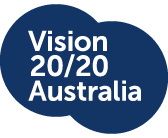I was diagnosed with keratoconus when I was fifteen, but I had glasses from age eleven and, against my wishes, was forced to permanently sit at the front of the classroom at school. The new glasses never seemed to be effective for very long and those four years of relatively rapid vision loss was the start of countless visits to optometrists and opthalmologists. Unbeknownst to me at the time, the frequent change in glasses prescription was the first tell-tale sign of this degenerative corneal disease. My mum still says today how grateful she is to the well-read ophthalmologist who suspected, but couldn’t be sure, what the cause of my vision loss was. Without delay I was referred to an optometrist who specialised in keratoconus—which at the time meant that he had seen keratoconus patients before!
Keratoconus is a condition that affects the cornea (the front surface of the eye). As a result of this thinning, the normally round shape of the cornea is distorted and a cone-like bulge develops, resulting in significant visual impairment. In the early stages, vision is correctable with glasses but with progression the cornea becomes highly irregular and hard contact lenses are required for adequate vision correction. One of the most frustrating things for me is people telling me to just wear glasses instead of contact lenses given they can give me so much grief but without my lenses I can’t see. In about 15% of cases, the central cornea becomes extremely thin and irregular and corneal transplantation surgery is required to restore vision. I’ve come close to needing a graft a few times, but thankfully contact lens technology has advanced slightly faster than the progression of my condition.
I will never forget the first pair of properly fitted contact lenses I received. For the first time in around five years, I could see that trees had leaves. I was previously able to see a shrub of green sitting above a trunk (a bit like a cartoon drawing), but not defined, green leaves. It seemed too that all the cars had also been washed! The sharpness and brightness of everything that surrounded me was quite overwhelming, and for mum too, I remembered she cried. Years later I realised how much the resilience of being diagnosed during my adolescence stood me in good stead to ‘roll with the punches’ and how distressing it was for my parents who feared, much more than I did, what the future might hold having a significant vision impairment.
The impact of keratoconus on my daily life is colossal. I often undervalue how contact lenses change my life. Without them, I’m house bound, unable to work, study, read, play or exercise. I cannot perform even the most basic of daily living tasks. The first thing I do when I get out of bed in the morning is fumble my way to the bathroom to put my contact lenses in. As for reading the time on the clock radio … if I can find it, I’m doing well! I don’t wish to make light of the extent of my vision impairment, but keeping a sense of humour is a saving grace.
I’m reminded of my vulnerability when I’m in unfamiliar environments. Generally this means when I’m travelling and on long plane flights when I’m forced to take my lenses out to avoid 24-hour lens wear! Having somewhere safe to clean my lenses is paramount and not always guaranteed on holidays. Staying in different accommodation – from camping to a five star resort – leaves me feeling uneasy if I have to get up during the night. Without lenses my personality changes, I become quiet, retreated and generally discombobulated. Granted it is temporary but relentless nevertheless.
I’m not alone, my mum and sister have keratoconus too. We allmanage our condition very differently, but there’s definitely a sense of comfort knowing that we truly understand what it’s like. These days, keratoconus is usually diagnosed by an optometrist using corneal topography (creates a 3D map of the cornea highlighting its curvature). Symptoms can be a sudden change of vision in just one eye; a blurring and distortion of vision; bright lights look like they have halos around them.
Keratoconus Australia (KA) provides support to people with keratoconus and their families and has operated with volunteers since 2000. I was one of a small group of patients involved its establishment and development. I was impacted by hearing about people whose keratoconus was not managed correctly and they knew of no options to enable them to see properly and live their lives. And unfortunately this still happens today. Over the fifteen years, KA has referred hundreds of people to experienced eye-carers, provided information seminars and advocated for better treatment options.
At times, I feel I have near enough spent my life in an optometrist’s chair, and more than a good portion of my life savings have been poured into expensive contact lenses for treatment. But I was and still am determined to not let keratoconus stop me doing the things I want to do in my life. I consider myself one of the lucky ones: I have an optometrist who keeps up-to-date with the latest treatment options available, the latest designs in contact lenses, and who is patient. This, as I’ve learnt, is the key to managing and living with keratoconus, which I have now for 20 years.
If you or someone you know would like further details on how to live with keratoconus, visit the Keratoconus Australia website www.keratoconus.asn.au
